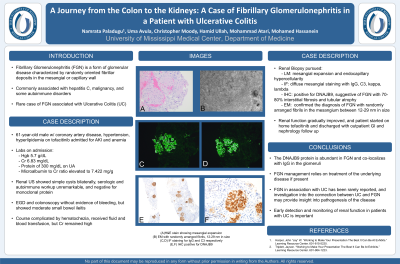Monday Poster Session
Category: IBD
P2721 - A Journey from the Colon to the Kidneys: A Case of Fibrillary Glomerulonephritis in a Patient With Ulcerative Colitis
Monday, October 28, 2024
10:30 AM - 4:00 PM ET
Location: Exhibit Hall E

Has Audio

Namrata Paladugu, BS, MD
University of Mississippi Medical Center
Fort Mill, SC
Presenting Author(s)
Namrata Paladugu, BS, MD1, Christopher G. Moody, DO2, Uma Mahesh Avula, MD1, Hamid Ullah, MBBS1, Mohammad Atari, MD1, Mohamed Hassanein, MD1
1University of Mississippi Medical Center, Jackson, MS; 2University of Mississippi Medical Center, Brandon, MS
Introduction: Fibrillary glomerulonephritis (FGN) is a form of glomerular disease that is characterized by randomly oriented fibrillar deposits in the mesangial or capillary wall and can be associated with autoimmune disorders. FGN has commonly been associated with Crohn’s disease. Here we present a rare case in which a patient with known diagnosis of ulcerative colitis (UC) on treatment with tofacitinib was found to have FGN.
Case Description/Methods: A 61-year-old male with a history of coronary artery disease, hypertension, hyperlipidemia, and UC on biologic therapy was admitted with acute kidney injury and anemia. Labs were notable for a hemoglobin of 5.7 g/dL and a creatinine of 6.83 mg/dL. Urinalysis showed 300 mg/dL protein and microalbumin to creatinine ratio was elevated to 7,422 mg/g. Renal ultrasound showed simple cysts bilaterally. Serologic and autoimmune workup was unremarkable, and monoclonal protein was not detected. He underwent esophagogastroduodenoscopy and colonoscopy, neither of which showed evidence of bleeding but showed moderate small bowel ileitis. Course was complicated by hematochezia. He received blood transfusion and fluid resuscitation, however creatinine remained elevated for which a renal biopsy was pursued. Pathology results showed mesangial expansion and endocapillary hypercellularity on light microscopy. Immunofluorescence showed diffuse mesangial staining with IgG, C3, kappa, and lambda. Immunohistochemistry and liquid chromatography mass spectrometry was positive for DNAJB9, suggestive of FGN with 70-80% interstitial fibrosis and tubular atrophy. Electron microscopy confirmed the diagnosis of FGN with randomly arranged fibrils in the mesangium between 12-29 nm in size. Renal function gradually improved, and the patient was restarted on home tofacitinib and discharged with outpatient GI and nephrology follow-up.
Discussion: Fibrillary glomerulonephritis has been associated with autoimmune diseases, hepatitis C, and malignancy. The DNAJB9 protein is abundant in FGN and co-localizes with IgG in the glomeruli. FGN management is challenging and relies on treatment of the underlying cause if present. FGN in association with UC has rarely been reported, and investigation into the connection between UC and FGN may provide insight into the pathogenesis of the disease. This case contributes to growing evidence of the complex nature of FGN and its association with autoimmune diseases, and the importance of early detection and monitoring of renal function in patients with UC.
Disclosures:
Namrata Paladugu, BS, MD1, Christopher G. Moody, DO2, Uma Mahesh Avula, MD1, Hamid Ullah, MBBS1, Mohammad Atari, MD1, Mohamed Hassanein, MD1. P2721 - A Journey from the Colon to the Kidneys: A Case of Fibrillary Glomerulonephritis in a Patient With Ulcerative Colitis, ACG 2024 Annual Scientific Meeting Abstracts. Philadelphia, PA: American College of Gastroenterology.
1University of Mississippi Medical Center, Jackson, MS; 2University of Mississippi Medical Center, Brandon, MS
Introduction: Fibrillary glomerulonephritis (FGN) is a form of glomerular disease that is characterized by randomly oriented fibrillar deposits in the mesangial or capillary wall and can be associated with autoimmune disorders. FGN has commonly been associated with Crohn’s disease. Here we present a rare case in which a patient with known diagnosis of ulcerative colitis (UC) on treatment with tofacitinib was found to have FGN.
Case Description/Methods: A 61-year-old male with a history of coronary artery disease, hypertension, hyperlipidemia, and UC on biologic therapy was admitted with acute kidney injury and anemia. Labs were notable for a hemoglobin of 5.7 g/dL and a creatinine of 6.83 mg/dL. Urinalysis showed 300 mg/dL protein and microalbumin to creatinine ratio was elevated to 7,422 mg/g. Renal ultrasound showed simple cysts bilaterally. Serologic and autoimmune workup was unremarkable, and monoclonal protein was not detected. He underwent esophagogastroduodenoscopy and colonoscopy, neither of which showed evidence of bleeding but showed moderate small bowel ileitis. Course was complicated by hematochezia. He received blood transfusion and fluid resuscitation, however creatinine remained elevated for which a renal biopsy was pursued. Pathology results showed mesangial expansion and endocapillary hypercellularity on light microscopy. Immunofluorescence showed diffuse mesangial staining with IgG, C3, kappa, and lambda. Immunohistochemistry and liquid chromatography mass spectrometry was positive for DNAJB9, suggestive of FGN with 70-80% interstitial fibrosis and tubular atrophy. Electron microscopy confirmed the diagnosis of FGN with randomly arranged fibrils in the mesangium between 12-29 nm in size. Renal function gradually improved, and the patient was restarted on home tofacitinib and discharged with outpatient GI and nephrology follow-up.
Discussion: Fibrillary glomerulonephritis has been associated with autoimmune diseases, hepatitis C, and malignancy. The DNAJB9 protein is abundant in FGN and co-localizes with IgG in the glomeruli. FGN management is challenging and relies on treatment of the underlying cause if present. FGN in association with UC has rarely been reported, and investigation into the connection between UC and FGN may provide insight into the pathogenesis of the disease. This case contributes to growing evidence of the complex nature of FGN and its association with autoimmune diseases, and the importance of early detection and monitoring of renal function in patients with UC.
Disclosures:
Namrata Paladugu indicated no relevant financial relationships.
Christopher Moody indicated no relevant financial relationships.
Uma Mahesh Avula indicated no relevant financial relationships.
Hamid Ullah indicated no relevant financial relationships.
Mohammad Atari indicated no relevant financial relationships.
Mohamed Hassanein indicated no relevant financial relationships.
Namrata Paladugu, BS, MD1, Christopher G. Moody, DO2, Uma Mahesh Avula, MD1, Hamid Ullah, MBBS1, Mohammad Atari, MD1, Mohamed Hassanein, MD1. P2721 - A Journey from the Colon to the Kidneys: A Case of Fibrillary Glomerulonephritis in a Patient With Ulcerative Colitis, ACG 2024 Annual Scientific Meeting Abstracts. Philadelphia, PA: American College of Gastroenterology.
